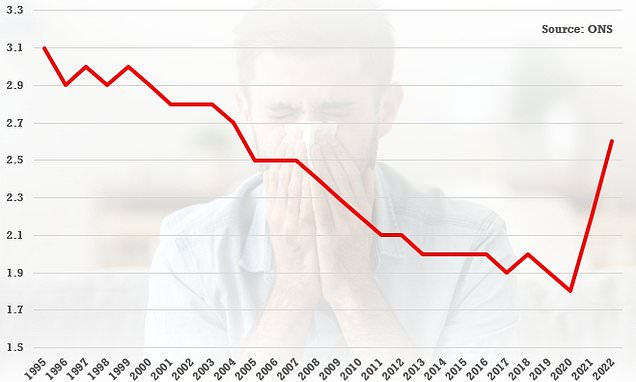Sicknote Britain: Working hours lost to illness and injury hits 18-year high – with Wales suffering by far the worst absence rate – as coughs and colds make a comeback after Covid
The rate of sickness absence spiked to the highest level since 2004 last year as coughs and colds made a comeback after Covid.
The proportion of working hours lost to illness or injury hit 2.6 per cent, up from 2.2 per cent in 2021.
At the height of the pandemic in 2020 it fell to just 1.8 per cent, with the lack of social mixing thought to have stopped bugs circulating.
However, the level detected by the Office for National Statistics in 2022 represented an 18-year high, dramatically reversing a long-term downward trend.
It was driven by an increase in ‘minor’ illnesses and respiratory conditions, even though the ‘other’ category – which includes Covid – fell.
About 185.6million working days were lost due to sickness or injury during the year.
That was a record high – but the workforce is significantly larger than before.
The proportion of working hours lost to illness or injury hit 2.6 per cent in 2022, up from 2.2 per cent in 2021
The rise was driven by an increase in ‘minor’ illnesses and respiratory conditions, even though the ‘other’ category – which includes Covid – fell.
ONS head of labour market and household statistics David Freeman said: ‘Sickness absence rose again in 2022, so that the proportion of working hours lost was the highest since 2004.
‘This comes after it dropped to its lowest ever rate at the start of the pandemic, when lockdown and furloughing reduced people’s exposure to minor illnesses.
‘Because the working population is much bigger now than it was nearly twenty years ago, in 2022 the total number of working days lost was the highest on record.’
The ONS analysis said: ‘While the virus may have led to additional absences, measures such as furloughing, social distancing, shielding and increased homeworking helped to reduce other causes of absence in 2020.
‘However, the reduction to the furlough scheme and its eventual end in September 2021, coupled with the decline in homeworking, shielding, and social distancing policies, and new COVID-19 variants, led to a rise in sickness absence in 2021 to above pre-pandemic levels.’
The figures showed that ‘respiratory conditions’ overtook ‘mental health conditions’ to become the fourth most common reason for absence in 2022.
The ‘other’ category – including diseases such as Covid and accidents – made up 23.8 per cent of the total hours lost. That was down from 26.9 per cent the previous year.
Wales had by far the highest sickness rate among the home nations at 3.6 per cent, with Scotland on 3 per cent. The level in Northern Ireland was 2.7 per cent, and in England 2.5 per cent.
London had the lowest rate at 2.1 per cent, with the ONS pointing to the younger age profile of workers and prevalence of high-skilled jobs that tend to have lower absences.
The absence rate was 3.6 per cent for public sector workers and 2.3 per cent for private sector, up 0.6 and 0.4 percentage points respectively from 2021.
Sickness has been higher in the public sector than the private for every year on record. The ONS suggested the types of jobs and better sick pay in the public sector could be behind the gap.
Lib Dem frontbencher Daisy Cooper said: ‘Behind these figures are millions of people across the country waiting in pain for treatment.
‘People cannot see their GP when they need to, dental practices are closing their doors to NHS patients, pharmacies are closing and waits for hospital treatment are through the roof.
‘It is no wonder that people have no choice but to take time off work. Patients are paying the price for this Conservative Government’s failure to invest in public health and its inability to bring NHS waiting times down and recruit more doctors.’
Wales had by far the highest sickness rate among the home nations at 3.6 per cent, with Scotland on 3 per cent. The level in Northern Ireland was 2.7 per cent, and in England 2.5 per cent.
Source: Read Full Article




